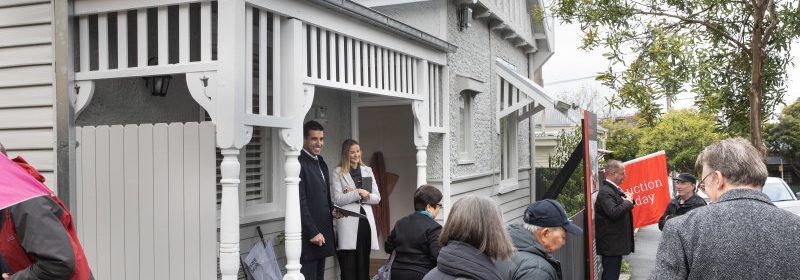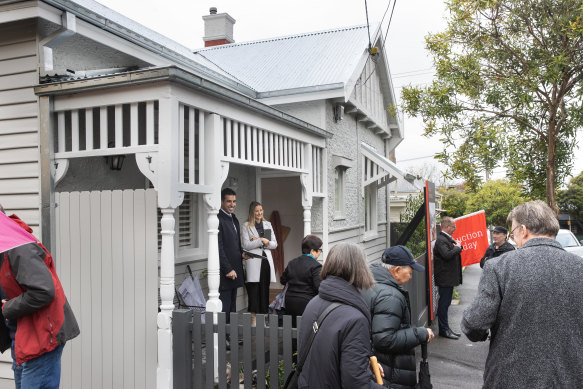Property values are now rising in four out five suburbs. Can it last?

Save articles for later
Add articles to your saved list and come back to them any time.
Property listings
Property values are rising in four out of five suburbs around the country, as the property market upswing broadens despite rising interest rates.
But the pace of growth has started to slow in Sydney and Melbourne, and last week’s interest rate hike casts a cloud over the outlook for the market.
The property market upswing has become more widespread.Credit: Simon Schluter
Values rose over the past three months in 83.1 per cent of house markets analysed and 80.6 per cent of unit markets, CoreLogic research found.
Sydney recorded rises in 91.4 per cent of house markets and 87.4 per cent of unit markets over the past three months to October.
The biggest rises were for houses in Five Dock, Oyster Bay, Penshurst, Concord West and Concord, which all gained more than 8 per cent in value in the quarter.
In Melbourne, 80.8 per cent of house markets rose and 75.4 per cent of unit markets rose over the same period.
The fastest increases were for houses in Ormond, Hampton East, Kingsbury, Northcote and Thornbury, which rose between 4.4 per cent and 6.7 per cent.
CoreLogic head of research Eliza Owen said prices have been rising despite higher mortgage repayments because there is more demand for housing than supply, as household sizes have reduced since the pandemic and the immigration program has returned.
“Even though there is a lot of pessimism about the state of inflation and weakening economic conditions, there are also a lot of people with the capacity to buy despite higher interest rates,” she said.
“Some of the upsizers who might be participating in the market may have had longer term capital gains they’re able to spend on the next purchase. Wealthier households and cash buyers such as downsizers are able to participate in the market despite rising rates as well.”
But Owen said the pace of growth was slowing in Sydney and Melbourne as stretched affordability and limits to borrowing capacity started to kick in.
More homes have been listed for sale in the winter and spring, and total listings are now slightly above their historic average, giving buyers a little more bargaining power, she said.
“In Sydney and Melbourne, ongoing price growth is going to be more tested in the months ahead,” she said.
“Seasonally we’re going to see lower volumes and demand. Prices may be affected by the November rate rises. There is a little uncertainty around cash rate expectations.”
But in more affordable cities Brisbane, Adelaide and Perth, prices are running at high speed and rising in more than 95 per cent of markets analysed. Total listings remain between a third and 40 per cent below average there, and price growth remains strong.
AMP chief economist Shane Oliver noted the shortage of homes compared to demand, which buoyed property prices this year after last year’s downturn.
“There’s a group of people who are less interest rate sensitive, who can access the bank of mum and dad, or had built up a lot of savings and were waiting for prices to stop falling before going in,” he said.
“As more people see prices going up, they’re attracted to the market because they feel they’ll miss out if they don’t get in.”
Even so, he said Sydney prices have been slowing a bit and Melbourne has lagged relative to elsewhere, while Perth, Brisbane and Adelaide prices stay at record highs.
Auction clearance rates have fallen since autumn, and there is a question mark over the outlook, he said.
“There’s an increasing risk that high interest rates with the still high risk of another hike may start to get the upper hand,” he said.
HSBC chief economist Paul Bloxham said strong population growth, particularly from overseas, was helping to push house prices higher.
There is a question mark over the outlook for property prices.Credit: Peter Rae
A tight rental market, made tighter by international students and workers travelling to Australia, was encouraging local renters in Sydney and Melbourne to buy rather than continue renting, he said.
“One of the primary forces supporting housing demand at the moment is strong population growth,” Bloxham said. “We do think population growth will slow down in the next few quarters and that will help in easing house price growth.”
Bloxham said the surprising thing about the current market was the fact interest rates had soared, but house prices were also still rising.
“That’s because of a lot more people in the market,” he said. “It’s offsetting the higher interest rates.”
Most Viewed in Property
Source: Read Full Article

